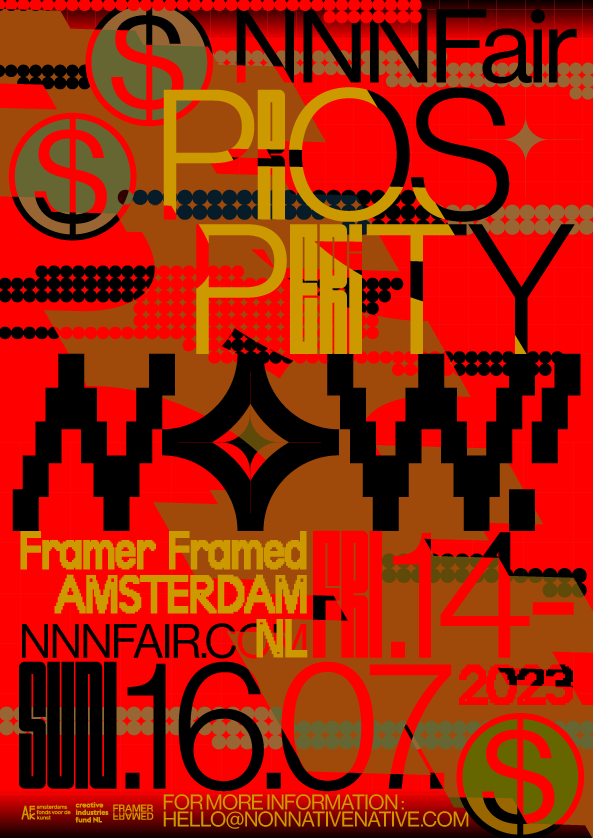DESIGNING FETISHISM
TYPE
Interview
DATE
December 2018
PLACE
Amsterdam
Having recently exhibited at CinemAsia’s LGBTQ programme, Our Lives Elsewhere, Malaysian multidisciplinary artist and designer Jonathan Ho is now busy preparing for his next show in Eindhoven. Currently based in Amsterdam, he is the founder of CHINTZD., a creative consultancy, specialising in the development of fetish gear and apparel. We sat down in his studio on a rainy afternoon to discuss sex, design and Asian identities.
NNN In your own words, could you please describe your practice?
JH At the moment, I am working between the fields of art and design. For instance, design brings in the money, and art is sort of the recreational, fun thing I do on the side, even though I wouldn’t define it in the traditional sense as ‘recreational’.
NNN But your background is in design, right?
JH Yes, that’s true, I started off with design. Actually, no. Originally, I was supposed to go to music school, but I ended up missing the audition, so I had to figure out what to do with myself. In the end, industrial design seemed like something for me, so I spent 4 years of my bachelor studying industrial design in Melbourne at the Royal Melbourne Institute of Technology. It was great. What I liked about industrial design was that it was very practical. There were conceptual aspects to it, but it was mostly about making things work, thinking about functionality. After that, I moved to The Netherlands where I did the MA Contextual Design at Design Academy Eindhoven.
NNN Why The Netherlands? What brought you here?
JH During my bachelors at RMIT, I went on an exchange to Helsinki at Aalto University to study furniture design in their MA program. There was an opportunity for this exchange, and at the time, I wanted to be a furniture designer. It was the intersection between engineering and art that really appealed to me. And then, a friend of mine was exhibiting at Dutch Design Week, and she invited me over, so I came, and I was so impressed and amazed, you know. I was thinking, “Oh my gosh, wow! The designers here have so much freedom and autonomy”
NNN I guess, Design Academy is probably the opposite to your studies. It’s quite a long way to come, from Melbourne to Helsinki and finally, Eindhoven.
JH But here, I really found my niche. I now work primarily in the fetish and sex industry.
NNN It’s probably illegal to do this in Malaysia, right?
JH Totally, because it’s predominantly a Muslim country.
In my practice, I try to have 3 words to define it, instead of an artist statement: post-orientalism, fetishism, and commerce. These are the main topics of interest that I’m exploring and researching at the moment. You know. A lot of these concepts aren’t very new, they have quite a rich history and narrative which is what I like. For example, the origin of the word “fetish” comes from the Portuguese word, “feitiço” which is a totem or a charm which you put magical powers on. It’s essentially an object in which you try to apply meaning and value. Then there’s the term sexual fetishism, which for me is about researching and trying to understand the visual language of popular culture and using these cues to create a sense of desirability within the object itself.
For example, in my design practice, I’m now designing the dark room for a sex club here in Amsterdam. This doesn’t only include the furniture and lighting, but the condom and lube dispensers and even the door handles as well. Something as simple as the ergonomics of a condom dispenser to the tactility and form of a door handle can make a huge difference in the way one experiences sex.
Another example is a project that I am working on with an American fetish wear company, and together, we are developing a modular harness system. They can be transformed and customised to the users’ bodies, based on how they want them.
It’s funny that in the end, I meet most of my clients through sex, for example, I met the owner of the American company at a sex party in Berlin.
NNN That’s a little further away from here.
JH This is what’s interesting in my practice; the fact that it can be exported from The Netherlands. There’s this mentality that the Dutch are so open-minded, and so liberal, and so free, and this attitude, especially when you combine it with fetishism and sex, it sells really well. It’s really not a bad dream to sell.
NNN No, it’s not because I also think that it’s such a specific market, and there’s definitely a need for that, even if it’s not out in the open, or not really seen as related to “the design world”. I think that the Dutch are definitely merchants. Historically, they were very advance in commerce.
JH Indeed, so I work mostly within the fetish industry, mostly the gay fetish industry because I’m gay, but also because I’m interested in how masculinity is presented and fetishised. It’s a continuation of my graduation project; the fetishism of masculinity. Especially now, I find it interesting when there’s all this talk about queerness and embracing femininity etc … Masculinity is then presented as this evil, toxic thing, but in the end, it is still desirable. This is what I have come to figure out.
NNN Definitely, and it’s not just in the gay scene. In the context of now, I guess masculinity is having a bit of a break at the moment …
One random question, are you familiar with design education or the industry in Malaysia, and how is that different to here?
JH There, the discourse is still about logos and making brands and products, some architecture, but even so, they haven’t really gone past Modernism, you know? That’s how developed they are so far.
NNN Do you feel then that the definition of design here and there is very different?
JH Totally.
NNN What do you think is the position of Asian designers within the Dutch creative industry?
JH I don’t know, but I do think that Asian designers really need to band together.
NNN Solidarity-wise?
JH Not for solidarity because it’s just going to be a lump of cliches; the Asians doing their thing, you know? I think it’s more on an attitude level, like a rebranding of what being Asian means, I think, within a Dutch context, or in an international context.
NNN For sure, although Asia is huge, and very, very multiple. It’s such a broad definition, so for us, our primary focus is within the East and South East Asian regions. This covers China, Korea, Japan to Indonesia, Myanmar, and Thailand, for instance.
JH It’s funny you mentioned Japan. Because when you mention Japanese design, immediately there’s this very prestigious position, compared to the rest of Asia. There’s a very big difference between Japanese designers and Chinese designers, for example. On the other hand, a Korean artist would sound way more interesting here than Korean designer.
NNN Really?
JH I think so. Korean design is developing, but I think in relation to who’s more dominant culturally on an international level, Korean artists seems to be more ‘there’ at the moment than Korean designers. You have artists like Kim Sooja, Do Ho Suh or Lee Bul that have made quite prolific names for themselves within the international contemporary art scene. I don’t think many here could name a famous or iconic Korean designer, so to speak, especially if we don’t include fashion design as part of the equation.
NNN That’s interesting because I know that Japanese architecture has been fetishised for years in the Western architecture world and they are their own category, separated from the rest of Asia. Japanese design has also been exported into the Western consumer world with brands like Muji or Uniqlo, as well as many internationally known fashion brands such as Yohji Yamamoto, Issey Miyake and so on … So I think the Western world has been very well exposed to Japanese design and architecture, and therefore, they’re much more dominant than the rest of Asia.
JH It’s funny you’re saying this because recently I read an article talking about how many Japanese designers only become successful in Japan after they’ve been recognised in the West, which is really fucked up.
NNN Do you think it has something to do with their sense of superiority and how the Japanese sees themselves, in relation to the Western power?
JH I think it’s more about this idea of export, or my new obsession nowadays — I like to use term Post-Orientalism, which I define on my own terms as separate from the current academic definition of Post-Orientalism, which is more Middle Eastern-centric and focused. For me, in the neo-capitalist economy that we live in, how does one export or commodify a vision of what you are apparently supposed to represent. Even though it might not necessarily be very true. For example, the concept behind Muji is all about having a pure, minimal, and clean lifestyle, but I know many Japanese who do not live like that.
NNN Of course, Muji is selling this ideology of minimalistic living by selling you more stuff, while most Japanese live in tiny spaces, which are usually cluttered, and that’s why the Konmari method had also come to exist, but that’s another issue. These are just ideas and impressions exported to the West and the rest of the world.
JH Exactly! It’s just a brand or a cultural image.
NNN It’s like the brand images you were referring to earlier, like Muji, where they project the picture perfect lifestyle of how you can live, even though it’s very far from reality. It’s really interesting when you were talking about the Japanese values of the export earlier because I feel that that’s how they see the rest of Asians too. For example, when I was in Japan for a wedding, and I say I’m from Thailand, no one’s really interested in me or what I had to say in a group conversation, but when I say that I live in The Netherlands or that I live in Europe, suddenly, I became a point of focus in the conversation circle. I became the exotic fruit. Things I said became more interesting to them, and they were much nicer to me because they don’t see me as Thai anymore, but they see that I have been exported and westernised and therefore, better, which is really messed up, in my opinion. I feel that this is perhaps rooted in Japanese Imperialism from the Second World War. This pride and sense of superiority they seemed to think about themselves, even though it’s definitely not the case anymore. We all know that the Asian power now lies in China.
JH What I like about China is that they’re not doing it the way Japan did.
NNN A lot less violent!
JH Japan was very aggressive, while China is all about soft political power or economical power. They’re beating Western capitalism by doing capitalism better, which is what I find very interesting.
NNN For sure!
JH On another note, I have hardly heard of Asians in the fetish scene. Of course there is Japan and their weirdness, but hardly anything about the other Asians, moreso in the queer scene. I don’t really hear about Asians as producers of the scene, so I think it’s really nice that you’re doing it, and you’re voicing up about it.
Totally, what I love about it is that because we don’t have anything to look back on, so we can actually invent and redefine however we want it to be. That’s what I think is very exciting at the moment, and from there, the West can learn from us.
Jonathan Ho
chintzd.com
Interview by Darunee Terdtoontaveedej


